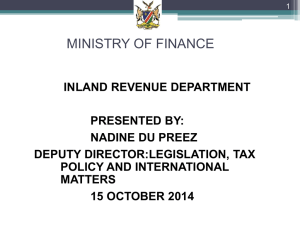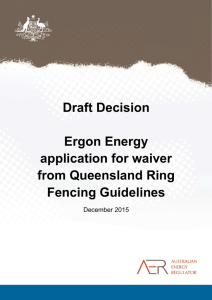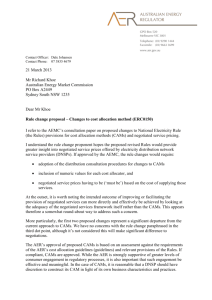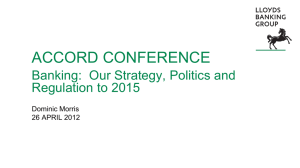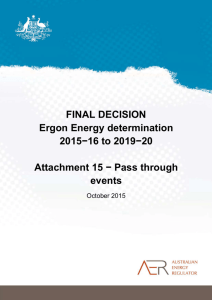Ergon Application for Ring Fencing Waiver
advertisement
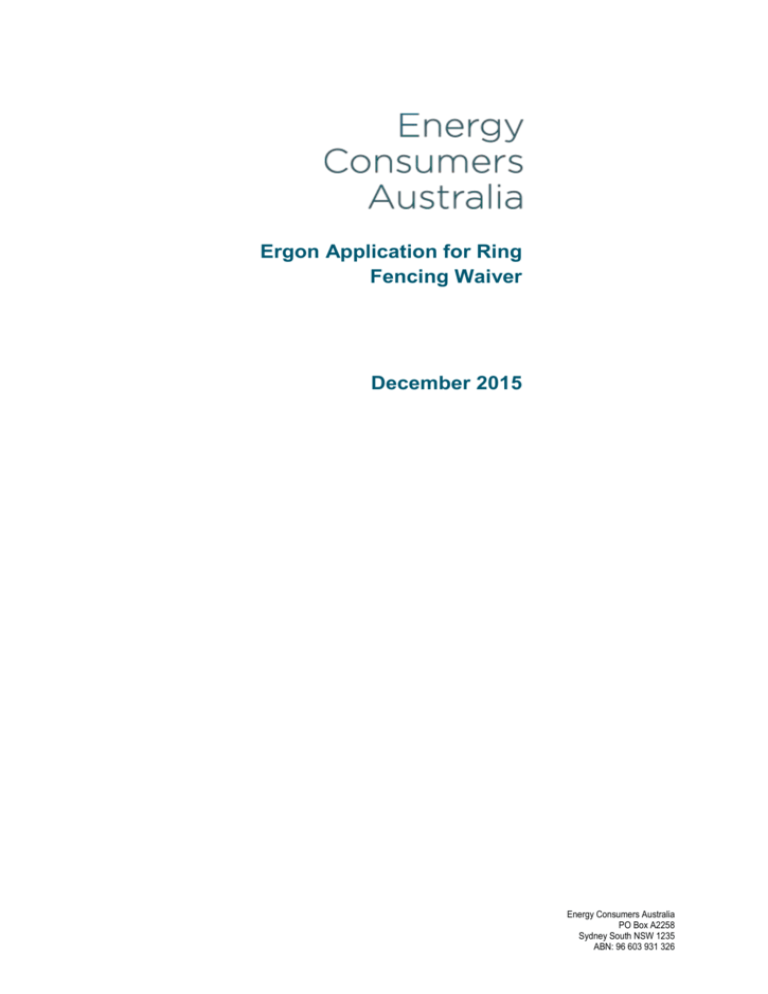
Ergon Application for Ring Fencing Waiver December 2015 Energy Consumers Australia PO Box A2258 Sydney South NSW 1235 ABN: 96 603 931 326 Ergon Application for Ring Fencing Waiver Background Ergon Energy Corporation has written to the AER on 28 October 2015 seeking a waiver of the ringfencing guidelines to apply to “the ownership and operation of Grid Utility Storage System (GUSS) units to augment Single Wire Earth Return (SWER) feeders and remove the need for traditional pole and wire upgrades” (the Application). Energy Consumers Australia opposes the waiver of the ring fencing guideline in this case. Further Energy Consumers Australia regards ring-fencing as an inadequate policy for dealing with the relevant issues. Materiality Ergon in its application notes that under section 21 of the ring-fencing guidelines the AER may issue a waiver “provided that the AER is satisfied that the DNSP can demonstrate that the administrative cost to the DNSP and its associates of complying with the obligation outweighs the benefit or any likely benefit to the public.” The issue of the balance between the costs and benefits has been argued by Ergon on the basis that the relevant installation is small. Competition and regulatory law processes are bedevilled with the problem of small increments. In any case where the incremental argument is mounted the decision maker needs to consider what will happen when the applicant increases the size of the exempt business by the same amount as already approved. At what point is the decision making no longer about the increment being applied for rather than the totality of the service? Clearly were the storage capacity being installed by Ergon much larger, none of the arguments for waiver would stand. Ergon argues that in installing the GUSS units it is not engaging in a business because they do not charge for the energy. Ergon claims that no ‘sale of electricity generated’ will occur. Ergon is potentially right that the GUSS product will not change customer energy usage (except in so far as it might increase due to greater reliability). However an imbalance will occur for these consumers. The energy that will be stored in the GUSS product will presumably be stored in periods of the day where the wholesale price of energy is lower and consumed when the wholesale use of energy is higher. Meanwhile the consumers on the line will pay existing tariffs which are probably only consumption tariffs. The retailer is obtaining a small marginal increase in margin on the back of the investment by the network provider. These are, indeed, all small amounts across the total NEM, or for any retailers and distributors involved. But it is not zero, and could be significant with wider deployment. If the customers were on a time of use tariff the issue is worse. 1 There exists a hypothetical alternative that the customers on the line could make an investment in storage to achieve the same outcome. Control The GUSS product has as one of its essential characteristics that it is a fully automated operation and is not under the control of the network. This augments the protection from the network utilising the GUSS for arbitrage. However the fact that it is fully automated means there is no essential reason why the GUSS product needs to owned by the network at all. That is, instead of the alternatives being GUSS owned by Ergon or GUSS owned by a ring-fenced entity that is owned by Ergon, there is a third alternative that Ergon contracts with a third party to provide the service of the GUSS product. The benefit of the third party arrangement is that if the number or size of units increases to the point where the trading in energy becomes significant this is well separated from Ergon. This will be particularly beneficial if there is a subsequent addition of solar PV to charge the batteries. Inadequacies of Ring-Fencing In the Position Paper attached Energy Consumers Australia has outlined why ring-fencing the operation of potentially competitive businesses inside regulated businesses is not good policy. In brief, any proposal to permit ring-fencing will foreclose the development of the competitive market. The case of the GUSS product is highly specific to SWER lines. However, to signal that the AER will countenance the operation of storage businesses by networks with or without ring-fencing will signal that network businesses will be allowed to participate in this market. Conclusion Ergon is faced with three options to deploy the GUSS product; 1. Deploy them as part of its own business with a waiver; 2. Deploy them through a ring-fenced operation; and 3. Deploy them by acquiring the operation of the GUSS product from a third party. Only the third of these is a sustainable long-term proposition. Ergon does not need the waiver to be able to procure the GUSS capability for its network, nor does it need to establish an entity to ringfence the product. The application for waiver should be declined. 2 Principles for the Integration of Energy Storage November 2015 Energy Consumers Australia PO Box A2258 Sydney South NSW 1235 ABN: 96 603 931 326 Integration of Energy Storage into the NEM Introduction The AEMC issued the Integration of Energy Storage: Regulatory Implications discussion paper in October 2015 (the Discussion Paper). ECA is aware that consumer advocacy organisations have made submissions to the discussion paper. ECA has not made a submission itself. Following the final report by the AEMC (due December 2015) there may be other regulatory processes. In this paper ECA outlines principles for the consideration of the integration of energy storage in the context of the long term interests of consumers. The intention is to frame the approach that ECA will take in relation to the further processes, including the AER review of the ring-fencing guideline. The objective of the national energy market arrangements is promoting the long term interests of consumers with regard to price, quality, reliability, safety and security of supply of energy services. Within the various laws this is specified as the promotion of efficient investment in, and operation and use of, energy services. At its simplest, the economics underpinning the regulatory concept of the long term interests of consumers says this is achieved when no individual could be made better off without making someone else worse off. Formally this is the condition of Pareto optimality, and economists define something as efficient if it achieves a Pareto optimum. Economic theory also tells us that this condition can be achieved through competitive markets and that prices are equal to long run marginal cost. Economic theory also tells us that there are circumstances where competitive markets are not only not viable, but are really not desirable. These are the cases of natural monopoly. The technical definition of a natural monopoly is an industry where multi-firm production is more costly than production by a single firm. The electricity distribution networks are one of the most commonly cited examples of natural monopoly. Theory then states that to achieve an efficient outcome the natural monopoly needs to be regulated so that it will produce the quantity of goods at the cost that would apply were the firm to be in a hypothetically competitive market. Unfortunately the criterion that the firm is a natural monopoly will almost certainly mean that the firm has economies of scale and hence has a declining marginal cost curve over all levels of output. As a consequence the regulated price is set at a higher price than marginal cost so that the firm doesn’t operate at a loss. To this point there would be vigorous agreement across participants in the energy market. The principles of the regulatory regime underpinning the National Electricity Market were established in the report of the Hilmer inquiry. A central condition was that the natural monopoly services of distribution and transmission networks should be strictly separated from markets that are contestable (or viable). 1 Counter-arguments can be found that vertical integration by monopoly firms into downstream markets can be dynamically efficient as a way to manage the co-ordination of the investment required. Vertical integration, however, creates its own set of challenges, often described in the literature as sabotage. Innovation in energy services is challenging the existing paradigm. The existence of “network embedded generators” – primarily rooftop photovoltaic (PV) panels – is changing the nature of distribution networks from one-way to two-way. The declining cost of battery storage is creating new opportunities for networks and now consumers to manage energy services. Embedded storage in the distribution network or on the customer’s own premises (behind the meter) adds a number of dimensions to this. Storage has the potential to reduce variability but also to increase it. This raises the important question of how these devices should be managed. This paper is only going to focus on the distribution network service provider (DNSP) role and whether a case has been made for varying the approach to regulatory separation. Arguments for DNSP involvement There are two basic arguments for DNSP involvement in storage, either in network or behind the meter. One is based on efficiency of provision of the service; the other is based on network management. The argument from efficiency is based on the claim that the network has efficiencies in scale or scope in managing these services. It is unclear exactly what aspects of network operation or asset base create this supposed efficiency. Certainly there is the prospect that network embedded storage has a scale efficiency over individual household storage. It may, however, have limitations that don’t apply to household storage. This argument is often related to a desire from DNSPs to develop “unregulated” revenue streams. The argument from network management is that embedded storage can work as an alternative to other network investments to manage peak loads. In its strongest form it has been argued that only the DNSP can properly manage these resources for the purposes of generating system stability. Argument against DNSP involvement If the DNSP is going to be involved in what is a potentially contestable market, the normal regulatory response is to propose “ring-fencing.” Ring-fencing can be an effective tool when previously integrated firms are being re-regulated; it is a way of insulating historic business units. An example is a consultancy business that might have been conducted by a DNSP. There are only two possible outcomes from ring-fencing; that it will be effective or it will be ineffective. The only party that can genuinely know whether ring-fencing is effective is the DNSP. If the ring-fencing is effective then the DNSP no longer has an incentive to exploit economies of scale or scope in the provision of the service. Indeed meeting the ring-fencing requirements introduces additional costs and is an inefficient solution. If the motivation is for network management purposes 2 these costs are probably greater than the costs the DNSP would face acquiring the benefits of storage as a contracted service. Given these considerations, the DNSP has no incentive to invest in storage services if the ring-fencing is effective. As a consequence if the DNSP invests in storage under the ring-fencing rules it can be inferred that the ring-fencing is ineffective. Other firms considering making an investment can only determine the effectiveness of ring-fencing on the basis of the behaviour of the DNSP. If the DNSP makes its own investment then other firms are more likely not to, because they will infer that the DNSP is making the investment to exploit its economies as the network owner and operator. If the DNSP has supported a regulatory outcome which permits their participation on the basis of ring-fencing, potential storage service entrants will infer that the DNSP is likely to invest. Consequently, even if ring fencing can be effectively enforced, permitting DNSPs to provide storage services will foreclose the market that would otherwise develop. Alternatives to DNSP involvement There are a small number of consumers who are eager participants in energy innovation. They tend to be people either motivated highly by environmental concerns, are interested in technology in general or are just keen to respond to perceived poor service and high prices from suppliers in the past. In general consumers will be better off with more choice in the provision of energy services. Existing and potential retailers are logical participants. Retailers have been slow to enter the market and their service offerings tend to be more focussed on churn-reduction through long term contracting rather than active engagement in the opportunity for customers. There have been a number of impediments to the full development of the retail market. This has included jurisdictions, in attempts to protect consumers or be tough on the businesses, creating barriers to entry by innovative firms. In the provision of storage embedded in distribution networks potential partners, generically, are generators who are simply relocating their generation activity. DNSPs could argue that they only want to install storage for the regulated part of their businesses, in network support and quality and reliability of supply. However, even were it likely that DNSPs would restrict their use to only these functions and not to energy trading or the ancillary services market, there are strong reasons to restrict DNSP involvement. The simplest part of the reasoning is the Averch-Johnson effect and the incentive for a rate of return regulated firm to inefficiently prefer capital expenditure over operating expenditure. Restricting DNSPs to the ability to buy network support and reliability “as a service” is the most effective way to mitigate this risk. 3 Additionally, restricting DNSPs to engaging in storage only as an acquirer of a service provides the DNSPs with the incentive to develop the processes and services needed to most effectively integrate both embedded storage and behind the meter storage. Conclusion Ring-fencing is not an effective way to control the damage that will occur to competitive markets by enabling DNSPs to invest in storage. The benefits that DNSPs can gain from embedded storage and behind the meter storage will be more efficiently delivered by the development of vibrant markets for these services. 4
